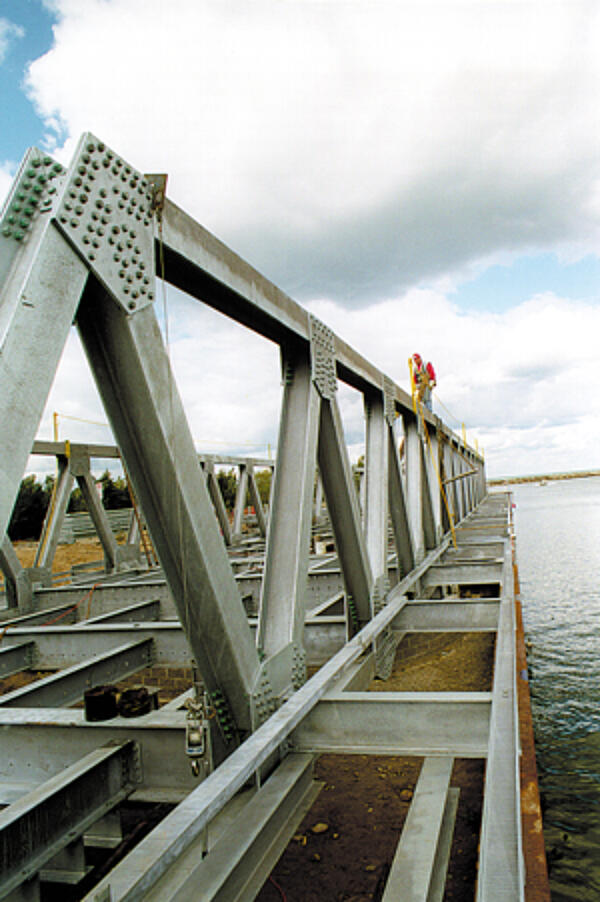Specifying Hot-Dip Galvanizing

Specifying hot-dip galvanizing is simply done by using ASTM specifications developed to produce high-quality galvanized coatings. The main specifications that pertain to hot-dip galvanizing are:
- ASTM A123 Specification for Zinc (Hot-Dip Galvanized) Coatings on Iron and Steel Products
- ASTM A153 Specification for Zinc Coating (Hot-Dip) on Iron and Steel Hardware
- ASTM A767 Specification for Zinc-Coated (Galvanized) Steel Bars for Concrete Reinforcement
All three of these specifications govern coating thickness, adherence, and finish for hot-dip galvanized coatings. A123 is the main specification and covers all types of galvanized products except fasteners and small parts which are covered by A153, and reinforcing steel bars, covered by A767.
All AGA members follow the ASTM standards. However, sometimes a galvanizer receives requests from designers/specifiers who use other galvanizing standards such as international ones or those produced by other organizations (SSPC, AASHTO, etc.) Here are a few common specifications from other entities occasionally used in North America:
- ISO 1461 Hot-Dip Galvanized Coatings on Fabricated Iron and Steel Articles - Specification and Test Methods
- CSA G164 Galvanizing of Irregularly Shaped Articles
- AASHTO M111 Zinc (Hot-Dip Galvanized) Coatings on Iron and Steel Products (similar to ASTM A123)
- AASHTO M180 Corrugated Sheet Steel Beams for Highway Guardrail
- AASHTO M232 Zinc Coating (Hot-Dip) on Iron and Steel Hardware (similar to ASTM A153)
These specifications have slightly different requirements for coating thickness, but most refer back to the ASTM specifications, and by following ASTM specifications the galvanizer will meet the requirements outlined in them.
Supporting Specifications
In addition to these three main specifications, there are a collection of supporting specifications related to hot-dip galvanized steel. There are four specifications the architect, engineer, and fabricator should be aware of before galvanizing, as they give best practices on steel selection and proper design:
- ASTM A143 Practice for Safeguarding Against Embrittlement of Hot-Dip Galvanized Structural Steel Products and Procedure for Detecting Embrittlement
- Practices to avoid strain-age embrittlement from cold working; absorption of hydrogen
- ASTM A384 Practice for Safeguarding Against Warpage and Distortion During Hot-Dip Galvanizing of Steel Assemblies
- Design practices to minimize issues due to the galvanizing temperature/stress relief
- ASTM A385 Practice for Providing High-Quality Zinc Coatings (Hot-Dip)
- Details on steel selection, design practices such as venting/draining, welding, etc.
- ASTM A1068 Practice for Life-Cycle Cost Analysis of Corrosion Protection Systems on Iron and Steel Products
- Calculation to analyze different steel corrosion protection systems (lccc.galvanizeit.org automates this calculation)
There are also three specifications specifiers may need for post-galvanizing considerations including:
- ASTM A780 Practice for Repair of Damaged and Uncoated Areas of Hot-Dip Galvanized Coatings
- Accepted forms of touch-up and proper repair for both in-plant and in-field
- ASTM D6386 Practice for Preparation of Zinc (Hot-Dip Galvanized) Coated Iron and Steel Product and Hardware Surfaces for Painting
- Details proper surface preparation for galvanized steel before painting
- ASTM D7803 Practice for Preparation of Zinc (Hot-Dip Galvanized) Coated Iron and Steel Product and Hardware Surfaces for Powder Coating
- Details proper galvanized surface preparation for powder coatings